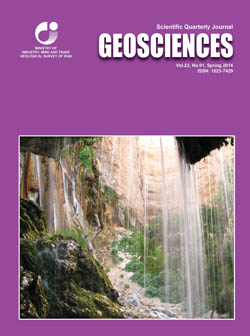Document Type : Original Research Paper
Authors
1 M. Sc., Department of Geology, Faculty of Sciences, Golestan University, Gorgan, Iran
2 Assistant Professor, Department of Geology, Faculty of Sciences, Golestan University, Gorgan, Iran
Abstract
The Now-Chun deposit, in the Kerman porphyry copper belt, with proved reserve of 268 Mt ore grading 0.034% Mo (100 ppm cut off) and 62 Mt ore grading 0.43% Cu (0.25 cut off), is the first known occurrence of Mo-rich,relatively Cu-poor porphyry mineralization in Iran which is studied from the mineralogical, l, and genetic point of view. The alteration and mineralization of the Now-Chun deposit is related to the highly differentiated porphyritic stock (rhyodacite) belonging to the Oligo-Miocene Mamzar batholith. Based on the present study, the main part of Mo and Cu mineralization in the Now-Chun deposit occurred more in the form of cross-cutting veinlets (stockwork) and less as dissemination type. The presence of molybdenite with/without chalcopyrite association in quartz-anhydrite-orthoclase-biotite potassic veinlets and chalcopyrite occurrence in primary quartz-magnetite veinlets is indicative of the priority of part of the Cu mineralization respect to the Mo during the primary stage of mineralization. The initial mineralization of Mo in the form of molybdenite occurred in quartz-anhydrite-orthoclase-biotite-pyrite-chalcopyrite. The weak correlation between Mo and Cu in the potassic alteration zone (r= -0.2) especially in the high grade ores indicates the difference between the enrichment conditions of both elements in responsible hydrothermal fluids for this alteration and mineralization zone. The presence of thick quartz-pyrite-chalcopyrite veinlets with sericitic halo and quartz-molybdenite without alteration halo either as independent or as intruded within early veinlets (quartz-molybdenite-anhydrite-orthoclase-biotite) have been associated with increasing of Mo and Cu grades in moderately phyllic alteration zone (sericitic and silicified rocks). The positive correlation between Mo and Cu in moderate phyllic zone (r≥ 0.0 to +0.5) which affected potassic ores indicates the similar behavior of both Mo and Cu during formation and evolution of the hydrothermal solution, which is responsible for the alteration and mineralization in the phyllic zone. This study revealed that the main concentration of Mo occurred in deep parts (potassic zone) of the deposit; whereas, Cu is associated with the shallow parts, especially with moderate phyllic zone which affected the potassic zone. As a result, the high grade Mo ores are not Cu-rich and vice versa. The present study indicated that the Now-Chun deposit in comparison with the Sar Cheshmeh deposit (Cu-Mo porphyry) is categorized within the Mo-Cu porphyry deposits. This sub-group of porphyry Cu and Mo deposit is attributed to the function of the Mo-rich and relatively Cu-poor hydrothermal fluids. The more differentiated composition of the ore-hosting porphyry in the Now-Chun deposit (rhyodacite) in comparison with the Sar Cheshmeh porphyry stock (granodiorite-quartzmonzonite), which indicates the late water saturation in its parent magma, was probably the factor of generating such fluids that could segregate the significant proportion of Mo in respect to Cu from the residual melts into H2O, alkalies and silica-enriched fluid phase which ultimately resulted in forming the Mo-Cu porphyry deposit.
Keywords

